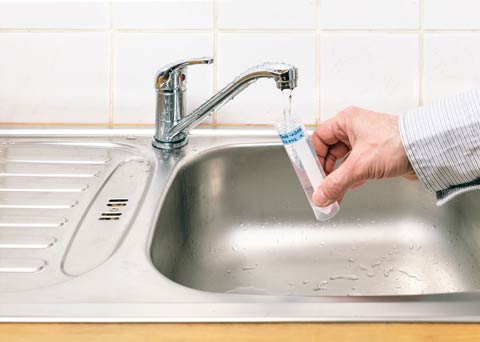Credit card commercials ask: “What’s in your wallet?” But here’s a better question…
“What’s in your water?”
Most of us have no idea. And the answer often isn’t pretty.
Carcinogens, lead, prescription drugs, pesticides, industrial chemicals, and fertilizers are all common contaminants in water systems around the nation. But how bad is the problem?
The U.S. Geological Survey and Environmental Protection Agency found 47 different pharmaceutical drugs in tap water across America.1
Another study found the powerful carcinogenic chemical 1,2,3-tricholoropropane (TPC) in the water supplies of 13 states.
And, of course, there was the famous lead crisis in Flint, Michigan. Children in the city suffered severe cognitive problems after unknowingly drinking tainted water for years.
Afterward, an investigation found that at least 3,000 neighborhoods around the nation had worse lead problems than Flint.2
Contaminants found in tap water are linked to cancer, brain damage, birth defects, fertility problems, and hormone disruption.3
And what does the government do about it?
In many cases, nothing. Often it has “allowable” limits on toxins that are ridiculously high. Most of the EPA’s limits far exceed those deemed safe by independent scientists.
For example, the EPA limit for arsenic in drinking water is 100 parts per billion. However, scientists with the California Office of Environmental Health Hazard Assessment say the limit of this powerful poison should be 4 parts per trillion.
That’s 25,000 times lower.
The EPA’s safe drinking water policies are such a sham that it hasn’t added a new chemical to its list of water pollutants in over 20 years. Scientists say that there are now over 160 unregulated—but dangerous—contaminants that guidelines don’t even address.4
How Does Poison Get into Your Drinking Water?
Agriculture is a leading source of the contaminants. Pesticides, fertilizer, manure, and animal drugs leech into groundwater. They end up in municipal water supplies. Farms are largely exempt from federal water pollution laws.5
Landfill seepage and manufacturing waste add even more toxins. People flush unused prescription drugs down the toilet. They eventually end up coming out of faucets. That’s because current regulations don’t require our water treatment systems to remove prescription drugs.
Check Your Water Now
The quality of your drinking water can vary greatly depending on where you live. Rural communities are often more at risk because of farm pollution.
It’s now easy to check what’s in your water. The Environmental Working Group has just released a national database of all the water systems in the country.6
Simply type your zip code into the Tap Water Data Base and hit “go.”7
The site will tell you which contaminants have been found in your water supply. And it reveals how the levels compare with state and national standards.
The system does not have data on private wells. If you are on well water, you’ll have to pay for your own testing.
How to Protect Yourself and Your Family
When you check your water, you’ll likely find areas of concern. Few systems deliver pristine water.
But if you think bottled water is the answer, you’re wrong.
Bottled water usually comes from municipal water supplies. In fact, it can actually be worse. Chemicals from plastic containers can contaminate bottled water.8
The best defense is to filter your tap water. The least expensive option is a carbon filter that fits atop a pitcher. The carbon filtration does a decent job removing most contaminants.
The most effective filter combines carbon filtration with reverse osmosis. These dual systems fit under your sink. They can also be added to your refrigerator water dispenser. They remove chemicals and most other contaminants. They cost around $200.
The highest level of protection is a full home purification system. It filters water before it enters your home. These systems cost $850 to about $2,600.
Water is essential to life. It’s the world’s most important nutrient. You want to make sure yours is as clean as possible.
Like this Article? Forward this article here or Share on Facebook.
References:
1 https://www.institutefornaturalhealing.com/2017/05/tap-water-likely-contains-least-8-drugs/
2 http://www.wbur.org/hereandnow/2016/12/29/reuters-investigation-lead-flint
3 https://www.ewg.org/tapwater/state-of-american-drinking-water.php#.WYDBbekg3IU
4 https://www.ewg.org/tapwater/state-of-american-drinking-water.php#.WYDBbekg3IU
5 https://www.ewg.org/tapwater/state-of-american-drinking-water.php#.WYDBbekg3IU
6 http://www.huffingtonpost.com/entry/put-in-your-zip-code-and-find-out-whats-in-your-drinking-water_us_597a08fae4b0da64e8775d01
7 https://www.ewg.org/tapwater/#.WYDBLukg3IU
8 https://www.banthebottle.net/articles/7-bottled-water-myths-busted/

